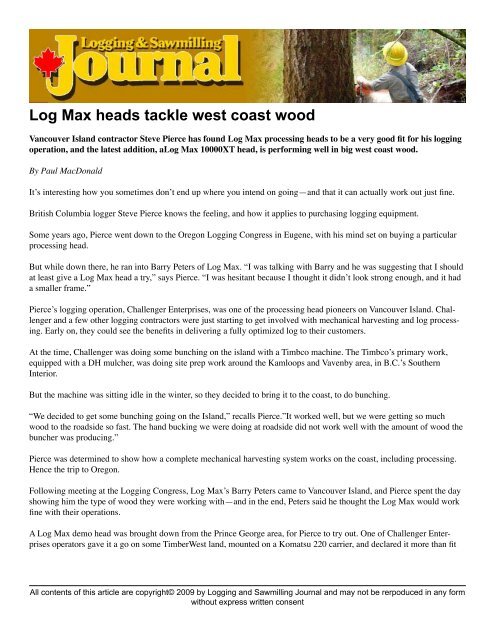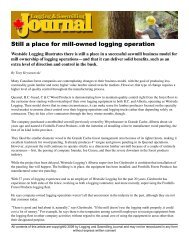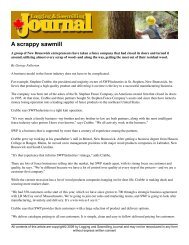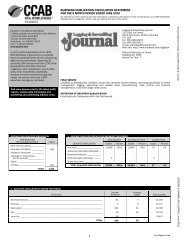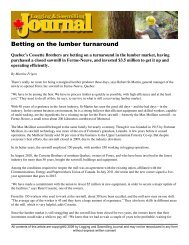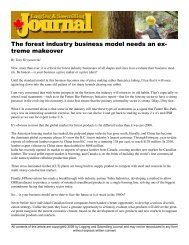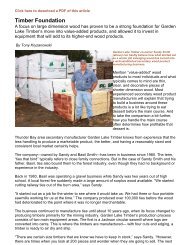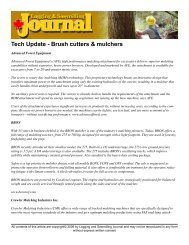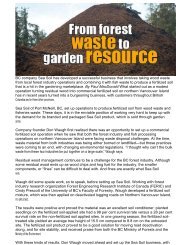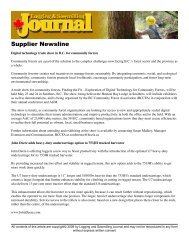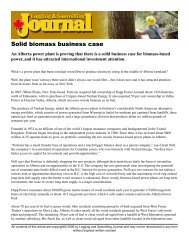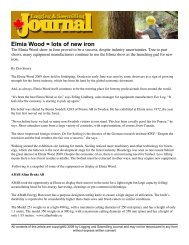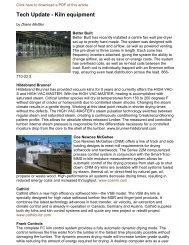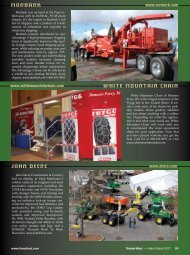Log Max heads tackle west coast wood .pdf - ForestNet
Log Max heads tackle west coast wood .pdf - ForestNet
Log Max heads tackle west coast wood .pdf - ForestNet
You also want an ePaper? Increase the reach of your titles
YUMPU automatically turns print PDFs into web optimized ePapers that Google loves.
<strong>Log</strong> <strong>Max</strong> <strong>heads</strong> <strong>tackle</strong> <strong>west</strong> <strong>coast</strong> <strong>wood</strong><br />
Vancouver Island contractor Steve Pierce has found <strong>Log</strong> <strong>Max</strong> processing <strong>heads</strong> to be a very good fit for his logging<br />
operation, and the latest addition, a<strong>Log</strong> <strong>Max</strong> 10000XT head, is performing well in big <strong>west</strong> <strong>coast</strong> <strong>wood</strong>.<br />
By Paul MacDonald<br />
It’s interesting how you sometimes don’t end up where you intend on going—and that it can actually work out just fine.<br />
British Columbia logger Steve Pierce knows the feeling, and how it applies to purchasing logging equipment.<br />
Some years ago, Pierce went down to the Oregon <strong>Log</strong>ging Congress in Eugene, with his mind set on buying a particular<br />
processing head.<br />
But while down there, he ran into Barry Peters of <strong>Log</strong> <strong>Max</strong>. “I was talking with Barry and he was suggesting that I should<br />
at least give a <strong>Log</strong> <strong>Max</strong> head a try,” says Pierce. “I was hesitant because I thought it didn’t look strong enough, and it had<br />
a smaller frame.”<br />
Pierce’s logging operation, Challenger Enterprises, was one of the processing head pioneers on Vancouver Island. Challenger<br />
and a few other logging contractors were just starting to get involved with mechanical harvesting and log processing.<br />
Early on, they could see the benefits in delivering a fully optimized log to their customers.<br />
At the time, Challenger was doing some bunching on the island with a Timbco machine. The Timbco’s primary work,<br />
equipped with a DH mulcher, was doing site prep work around the Kamloops and Vavenby area, in B.C.’s Southern<br />
Interior.<br />
But the machine was sitting idle in the winter, so they decided to bring it to the <strong>coast</strong>, to do bunching.<br />
“We decided to get some bunching going on the Island,” recalls Pierce.”It worked well, but we were getting so much<br />
<strong>wood</strong> to the roadside so fast. The hand bucking we were doing at roadside did not work well with the amount of <strong>wood</strong> the<br />
buncher was producing.”<br />
Pierce was determined to show how a complete mechanical harvesting system works on the <strong>coast</strong>, including processing.<br />
Hence the trip to Oregon.<br />
Following meeting at the <strong>Log</strong>ging Congress, <strong>Log</strong> <strong>Max</strong>’s Barry Peters came to Vancouver Island, and Pierce spent the day<br />
showing him the type of <strong>wood</strong> they were working with—and in the end, Peters said he thought the <strong>Log</strong> <strong>Max</strong> would work<br />
fine with their operations.<br />
A <strong>Log</strong> <strong>Max</strong> demo head was brought down from the Prince George area, for Pierce to try out. One of Challenger Enterprises<br />
operators gave it a go on some TimberWest land, mounted on a Komatsu 220 carrier, and declared it more than fit<br />
All contents of this article are copyright© 2009 by <strong>Log</strong>ging and Sawmilling Journal and may not be rerpoduced in any form<br />
without express written consent
for handling the large and heavy <strong>coast</strong>al <strong>wood</strong>. “He really liked the power it delivered,” recalls Pierce.<br />
To make this long story shorter, that was way back in 1997—and since then Challenger Enterprises has been a very<br />
faithful, and satisfied, <strong>Log</strong> <strong>Max</strong> customer. They have had a number of <strong>Log</strong> <strong>Max</strong> <strong>heads</strong>, including three 750 <strong>heads</strong>. Then<br />
they went to the 9000 <strong>heads</strong>, and these days they now have the latest large head, the <strong>Log</strong> <strong>Max</strong> 10000XT.<br />
Pierce admits there have been challenges along the way, and he credits logging equipment veteran Olle Melin and <strong>Log</strong><br />
<strong>Max</strong>, for helping him through some difficult patches.<br />
There were some trying times with the <strong>Log</strong>Mate computer, and its measurement system. It was originally designed for<br />
short <strong>wood</strong>. “It can be hard with some of the computer systems on logging equipment,” says Pierce. “You can solve three<br />
problems, and it creates another four problems.”<br />
Essentially, over the years, Pierce, like a lot of other logging contractors, has gone from fixing equipment such as processing<br />
<strong>heads</strong> with wrenches to fixing them with a laptop computer.<br />
Pierce says he has always let <strong>Log</strong> <strong>Max</strong> know that he is happy to work with them on new equipment, and demo it. “I’ve<br />
said to them, if you’ve got some ideas you want me to work with, if you’ve got something new, bring it over. I’ll put in on<br />
and try it out.<br />
“I’ll gladly try it out, but I won’t necessarily buy it,” he added. As the saying goes, famous last words.<br />
Pierce has operators who have run all kinds of harvesting and processing <strong>heads</strong> for a long time, and they’re happy to<br />
provide opinions and assessments of equipment.<br />
“We tried the <strong>Log</strong> <strong>Max</strong> 10000XT and it is very impressive,” says Pierce. “The way things are going on Vancouver Island,<br />
the <strong>wood</strong> is getting smaller and smaller. So we can do about 90 per cent of the work we need to do mid-Island with the<br />
<strong>Log</strong> <strong>Max</strong> 7000 and 9000.<br />
“But once we get up to the North Island, around Campbell River, the <strong>wood</strong> is a lot heavier.” He notes that timber in the<br />
B.C. Interior is about .8 metric tonnes per cubic metre, and on the south island it’s about 1.0 metric tonnes per cubic<br />
metre. On the North Island, it comes in at about 1.2 tonnes per cubic metre.<br />
“That’s quite a difference,” he says. “You notice it—it’s harder on the equipment. And with the ground, it’s tough to get<br />
around, with higher stumps. It’s a different logging world.”<br />
Pierce notes that they run four <strong>Log</strong> <strong>Max</strong> processing <strong>heads</strong>, and they don’t need the 10000XT everywhere they work—<br />
simply because they don’t have big <strong>wood</strong> on every site. Having said that, the 10000XT clearly does the job for them,<br />
handling the larger <strong>wood</strong>.<br />
All contents of this article are copyright© 2009 by <strong>Log</strong>ging and Sawmilling Journal and may not be rerpoduced in any form<br />
without express written consent
Although rated for 20 and 23 inch <strong>wood</strong>, Pierce notes that they can handle up to 28 inch, and even 30 inch diameter trees<br />
with their <strong>Log</strong> <strong>Max</strong> 7000 and 9000 processing <strong>heads</strong>. “They are tough <strong>heads</strong>.”<br />
But with 30 inch <strong>wood</strong>, they used to have to maneuuver the timber around, put the timber on the ground, and then run the<br />
head up. “We don’t need to do that any more,” says Pierce. “We just run the larger logs right through the 10000.” Operators<br />
appreciate the bigger arms and the larger cylinders on the head.<br />
<strong>Log</strong> <strong>Max</strong> takes a different approach with its design. Some <strong>heads</strong> in the market will have only one set of arms, and keep the<br />
tree up against the measuring wheels. “<strong>Log</strong> <strong>Max</strong> has two sets of arms, though, and the wheels squeeze the trees hard from<br />
the side, and the arms keep the trees up against the body. It’s a different concept.”<br />
And it works. “We’ve never had any complaints about quality in terms of measuring,” says Pierce.<br />
The heavier head comes with a cost, though, he notes. They run it on a 2850 Madill carrier. “With our machines, we have<br />
live heels. But with the 10000, the heel was just too much for the machine, it was too heavy, so we took it off.<br />
“Having a live heel is nice—if you get into steep ground, you have help to get yourself around. Or in wet ground, if you<br />
get stuck, you maneuver yourself around. We’d need to get into the next size machine, if we wanted to use a heel.”<br />
In the past, Challenger Enterprises was a sub-contractor, doing bunching and processing work for other contractors or<br />
companies on Vancouver Island.<br />
In recent years, though, the company has moved into doing stump to dump work, and has been doing some timber sales.<br />
“The <strong>wood</strong> is a little bigger with the timber sales, and the 10000 really shines when you are in the bigger <strong>wood</strong>.”<br />
The <strong>Log</strong> <strong>Max</strong> <strong>heads</strong> have to do little in the way of delimbing, Pierce says. When they are working in Douglas fir, for<br />
example. After it is cut, and hoe chucked forward, there are hardly any branches left.<br />
“That’s partly why with all our <strong>heads</strong>, we can get 12,000 to 13,000 hours out of them, no problem. That’s a lot of it. The<br />
delimbing can be hard on the <strong>heads</strong>.” Cedar branches can be a particular bear to get off though, he added.<br />
Pierce says they generally have good uptime with their <strong>Log</strong> <strong>Max</strong> <strong>heads</strong>. When they need help, they can usually troubleshoot<br />
problems over the phone with <strong>Log</strong> <strong>Max</strong> reps.<br />
<strong>Log</strong> <strong>Max</strong> is based out of Kamloops, in the heart of the interior of British Columbia with a distribution territory that covers<br />
British Columbia, Alberta, Saskatchewan and Manitoba.<br />
Following the design philosophy of the XTreme Series, the <strong>Log</strong> <strong>Max</strong> 10000XT is a head for large timber, says the company.<br />
It was developed specifically for tracked carriers, and is available in a choice of harvester or dedicated processor.<br />
The 10000XT cuts <strong>wood</strong> up to 900 mm in diameter and both versions feature integrated top saw.<br />
With completely new one-piece cast roller arms and felling link, the 10000XT is a large-size head, but with a weight of<br />
only 3030 kgs, including rollers and rotator. This means the head can be mounted on a smaller size carrier, leading to<br />
All contents of this article are copyright© 2009 by <strong>Log</strong>ging and Sawmilling Journal and may not be rerpoduced in any form<br />
without express written consent
savings in both machine and fuel costs.<br />
The <strong>Log</strong> <strong>Max</strong> 10000XT has powerful 1404cc roller motors equipped with all new steel rollers and a powerful 30cc saw<br />
motor with ¾ pitch chain. The processor style delimbing knives have replaceable edges and mechanical stops.<br />
The processor configuration of the <strong>Log</strong> <strong>Max</strong> 10000XT is equipped with integrated top saw and processor link. The<br />
standard processor head weighs in at 2,970 kgs. It features a feed force of 9555 lbf and feed speed of 13.8 fps.<br />
The <strong>Log</strong> Mate 402 on the 10000XT is said to be an easy to use control system with enhanced capabilities and state of the<br />
art “4 wire” CAN-BUS communication for all head control functions. A powerful high performance controller rapidly<br />
processes information for precise head positioning and cutting, with the logs consistently merchandized.<br />
The system features automatic control of up to 160 preset lengths and diameters along with programmable tolerances,<br />
assuring full conformance to a broad range of mill log specifications, says <strong>Log</strong> <strong>Max</strong>.<br />
The <strong>Log</strong> Mate 402 is easily adaptable to a full range of carriers. Harvesting and processing efficiency is always maintained<br />
through fully customizable control buttons with automatic functions for up to five different operators.<br />
All of these features help keep the processing equipment running, and help contractors stay efficient.<br />
And for contractors such as Steve Pierce, bunching and processing is the key part of the efficiency equation.<br />
“The hardest jobs out there are bunching and processing. With the bunching, you have to make sure the tree is felled<br />
properly, and you don’t have any snags, no trees get caught up. Then you have the processor and the loader.”<br />
Moving into doing stump-to dump seemed to be a natural progression, he says. “We were already doing the hardest<br />
things—with the harvesting and the processing, you already have the biggest investment in machinery.” So the move into<br />
stump to dump seemed natural.<br />
“We had worked for a couple of good contractors, and they kind of got fed up and got out of the business, and we decided<br />
to go full into it.”<br />
As with all things related to logging and the forest industry these days, the margins are slim, so he relies on efficient<br />
equipment. “Going stump to dump is working out, but it isn’t easy. It’s been a tough industry the last few years, with very<br />
slim margins.”<br />
But, he notes, the log market seems to be improving, with prices slowly moving in the right direction.<br />
“But it’s still a struggle out there,” he says. “We’ve got to keep adapting—but that’s the logging business, isn’t it?”<br />
All contents of this article are copyright© 2009 by <strong>Log</strong>ging and Sawmilling Journal and may not be rerpoduced in any form<br />
without express written consent


